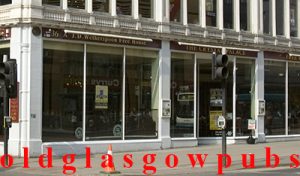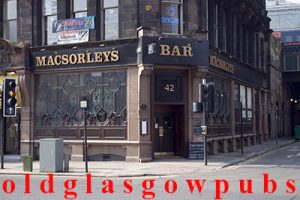9-11 Jamaica Street, Glasgow.

To read the full history of Rutherford’s in Jamaica Street click here to read about our second book.
9-11 Jamaica Street, Glasgow.

To read the full history of Rutherford’s in Jamaica Street click here to read about our second book.
Jamaica Street, Glasgow. Tel: 0141 248 4554.

Osmosis. 1991.

Osmosis. 2008.
36 Jamaica Street, Glasgow. G1 4QD. Tel: 0141 221 2624.

The Crystal Palace opened in August 2000.
This pub is something of an architectural landmark. Designed by John Baird, its iron and glass construction was inspired by Joseph Paxton’s Crystal Palace, a huge greenhouse-like building, the centrepiece of the Great Exhibition of 1851. It was built during 1855–1856 to the designs of John Baird, who had used an exposed iron frame as early as 1827 in the hammerbeam roof of the nearby Argyll Arcade.

The iron and glass structure of the building now occupied by this J.D. Wetherspoon free house “The Crystal Palace” was inspired by Joseph Paxton’s famous Crystal Palace.
A pioneering departure from traditional building methods, the Crystal Palace was a huge greenhouse-like building, with over a quarter of a million paned of glass. The centre-piece of the Great Exhibition of 1851, it was 600 yards long and tall enough to enclose the mature trees of London’s Hyde Park.
Joseph Paxton was head gardener to the Duke of Devonshire at Chatsworth in Derbyshire. In the late 1830s, he designed a glasshouse at Chatsworth using ideas later incorporated in his Crystal Palace.
Iron framing had been used to construct fireproof factories since the late 1700s. Not long afterwards, English glassmakers adopted French technological innovation, and by the 1840s, large sheets of plate glass could be made. Paxton’s inspiration was to combine the two ideas into a structural whole.
The success of Paxton’s Crystal Palace earned him a knighthood, and £5,000 from the profits of the Exhibition. He later became MP for Coventry. Paxton also designed Glasgow’s West End Park – better known as Kelvingrove Park – and advised the layout of Queen’s Park.
Do you remember any of the old pubs on Jamaica Street? If so please leave a comment.
Do you have any memories of the Crystal Palace? If so please leave a comment.
42 Jamaica Street, Glasgow. G1 4QG. Tel: 0141 248 7629

There has been licensed premises here since 1861 owned by William Dryburgh. In 1889 George McGregor took over the running of this popular pub.

George McGregor hailed from Perthshire he also owned the Clan Vaults. He blended his own whisky on the premises. The traveller could stay in one of the ten well ventilated rooms available. McGregor continued as licensee until 1890.
The next licensee for the old Clan Vaults, 44 Jamaica Street was Gray Edmiston as well known property owner and businessman in Glasgow. Mr Edmiston owned several well known bars in the city including the Lyceum Vaults, 145 Trongate and the Camel’s Head Vaults at the Royal Theatre, Cowcaddens.
In 1887 Mr Edmiston was at the Licensing Courts, trading at 87 Cowcaddens, (Camels Head,) he sought to open his old entrance to the back bar and restaurant, but was refused. Mr Edmiston explained to their honours, some of whom visited the premises, that formerly there were three entrances for the front and back bars, that on the latter he expended some £300 to meet the requirements of a rising business, and satisfy the views of the authorities. When a man fits up the premises at great outlay, lavatories, open fires, comfortable sedans and all the other luxuries.

The old Clan Vaults was entered from Jamaica Street by a very elegant tiled entrance, under the sign of the Golden Grapes, there was a snuggery on either hand, while in front was a screen to shield those at the bar from the vulgar gaze of the passers-by, on whose painted glass panels was inscribed the words, “Clan Vaults,” and pictures of the Camel’s Head (Mr Edmiston’s trade mark,) which, with design in flowers, fruits &c., formed a very striking feature of the pub. In front of you was not a horse shoe, but a half moon bar fitted with all the most recent modern aids to those in charge, in the way of cork-drawers, pumps, &c.&c. The bar proper, that is, behind those behind the counter, contains barrels of a quaint design with silver hoops, forming, with the bottles and coloured glasses, an effective background.
The premises were entirely repainted in 1891, outside and in, and the handsome Japanese paper on the walls gave an air of richness, warmth and comfort. Passing in, on the right hand is the gentlemen’s lavatory, light, airy and roomy. While in a sheltered nook a dram and social crack can be had openly at a little round table in the Continental style.
Midway in the passage, between the ordinary and first class bars, is the ladies room, specially fitted up for their convenience, an important desideratum too often over-looked. On the opposite side is a large, well-appointed room, called No.2, but pass on, and into, the first-class bar, only stopping to admire the Ann Street entrance. Entering no5 Ann Street, the Clan Vaults was engraved on a marble floor as you go in. This bar like the front bar was a half moon shape, and was one of the most elegantly appointed in the city. The counter was overtopped with white marble, while the walls were enlivened by elegant, mahogany cased plain mirrors. Merely glancing at the handsome plush upholstered furniture also of mahogany, and remarking the fireplace with its painted tiles. Civil young ladies were employed as waitresses. Gray Edmiston sold the pub to Philip MacSorley in 1897.

Still known as the Clan Vaults, Philip MacSorley took over the old premises in 1897, he commissioned architects Clarke & Bell and R A Bryden to built a new tenement with a pub on the ground floor on the site of the old pub. The new building was completed in 6 February 1899.
MacSorley’s new bar opened in 1899, situated at the corner of Jamaica Street and Ann Street. The interior had a large mahogany oval shaped bar counter with neat little recesses which could hold parties of five or six. At the further end a smaller snack bar and oyster counter had been fitted. Electric lights were installed and a new heating system fitted, the massive cellar was now underground with an extensive kitchen and the new toilets were the most up-to-date in town.

In 1904 MacSorley’s had a reputation of being the quickest service restaurant in the city. A dining room and grand smoking room was soon added with a room for the ladies as well as an American cocktail bar. All the best drinks were served here including Champagne and MacSorley’s special blend of Peacemaker whisky. MacSorley owned other city pubs including Maitland Street, Garngad, the Hampden Vaults, Crossmyloof, Holland Street and Dumbarton Road.

Malcolm McIntyre took over after MacSorley in 1910. Mr McIntyre and his father came to Glasgow from Stornoway, where they had carried on a very successful hotel business. On arriving in Glasgow they soon purchased Lauder’s Bar, Sauchiehall Street and MacSorley’s, Jamaica Street together with another pub at Anderston Cross with Archibald Lauder’s wholesale business in West George Street.
In 1920 they disposed of the retail business while retaining the wholesale department of Lauder’s famous “Royal Northern Cream.”
Malcolm’s sister ran the Royal Station Hotel, Forres, his entire family seemed to be involved with the licensed trade at some time in their lives.
Malcolm died in 1932 after a long visit to Canada where he had important interests. Shortly after his arrival in Glasgow he was taken ill and died as a result.



The old tiled floor was discovered in 209 after alterations. The floor covering was pulled up and revealed this very old tiled floor. After hard work of trying to clean the tiles up this magic floor look great.

Great food is always served at MacSorley’s Bar. After eating up here you have a great view of the area below.

During the 1980s the pub was known as Montego Bay.
I received an email from MacSorley’s Bar on 9 December 2009, the pub has been refurbished and opened again which I’m sure will be a great success as a music venue. On refurbishment the old floor was lifted and the mosaic tiled floor which had been underneath the floorboards for many years.
Good Luck in your new venture. CHEERS.
Update 12/12/2013…
Michael Smith is the owner of one of Glasgow’s best known live music bars MacSorley’s.
Good Luck to Mr Michael Smith.
If you are one of the few people who have never been in MacSorley’s Bar then you are missing out in one of the best live music bars in town. Great Music, live entertainment, and very reasonable prices.
Update January 2016…
One of Glasgow’s most iconic pubs is set to close next month. MacSorley’s on Jamaica Street has been a local favourite for music lovers for over 100 years!
A statement from the manger confirmed the grim news “We are sad to announce the closing of the doors, fittingly on Sunday 14th February. In the spirit of THE LAST WALTZ the weekend will feature all the usual suspects as well as some very special guests. Please join us and show some love as we say goodbye.”
Hopefully someone will take over this premises as a pub and keep the great history alive.
Update September 2016…
I received an email from JB that MacSorley’s opened at the end of June 2016: Hi John
Enjoyed your info on Macsorleys on Jamaica street.
The pub re-opened at the end of June 2016,
I’m not to clued up by whom but… There’s live music on a Thursday, Friday, Saturday & Sunday.
Including 3 acts on Saturday & Sunday.
Jazz on Saturday afternoon – was a trio followed by a big band this Saturday, then s rock band in the evening.
Sunday is tribute day, two acts in the afternoon then one in the evening.
Full info available on facebook “macsorleys 2016”
J.B.
We at Old Glasgow Pubs will give MacSorley’s a surprise review soon.
If you have anything you would like to add just email me at john@oldglasgowpubs.co.uk
Click here to read review for this pub
Philip MacSorley had his own blend of whisky called “Peacemaker.”
In 1878 Philip MacSorley was a traveller for (A D McDougall) wine merchant, 104 West Campbell Street.
In 1886 Philip MacSorley was a commercial traveller for (Taylor & Ferguson) wholesale wine and spirit merchants, 38 Oswald Street, goods entrance 37-45 Ann Street, this was very near to where he built MacSorley’s Bar. Philip’s address was 7 Regent Park Terrace, Strathbungo.
In 1899 MacSorley had public houses at 72 Maitland Street, 131 Garngad Road, 1 Spring Place, Crossmyloof, 1147 Pollokshaws Road, 44 Jamaica Street,and 148 Holland Street and was living at 10 Queen Margaret Crescent.
In 1925 Philip MacSorley, Spirit Agent at offices, 93 Hope Street, he was living at Buckingham Street.
Kenneth MacLennan was manager of MacSorley’s Bar, Jamaica Street prior to 1914 and possibly after the first world war war, he was originally from Avoch on the Black Isle.
Do you have any memories of MacSorley’s? If so please leave a comment.
